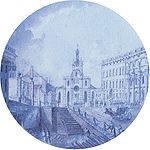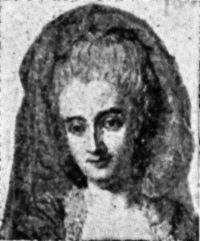
Elisabeth Lillström
Encyclopedia


NEE
NEE is a political protest group whose goal was to provide an alternative for voters who are unhappy with all political parties at hand in Belgium, where voting is compulsory.The NEE party was founded in 2005 in Antwerp...
Söderman (1717 – 4 April 1791) was a Swedish stage actor and opera singer, one of the first professional native female actors in Sweden, mother of Elisabeth Olin
Elisabeth Olin
Elisabeth Olin was a Swedish opera singer and a music composer. She is referred to as the first Swedish Opera prima donna. She was a court-singer . She was the first female member of the Royal Swedish Academy of Music...
, née Lillström. She was one of the group of pioneers and the prima donna
Prima donna
Originally used in opera or Commedia dell'arte companies, "prima donna" is Italian for "first lady." The term was used to designate the leading female singer in the opera company, the person to whom the prime roles would be given. The prima donna was normally, but not necessarily, a soprano...
of the first native actor generation in the theatre of Bollhuset
Bollhuset
Bollhuset, also called ', ', and ' at various times, was the name of the first theater in Stockholm, Sweden; it was the first Swedish theater and the first real theater building in the whole of Scandinavia. The name "" means "The Ball House", and it was built in 1627 for ball sports and used in...
in Stockholm
Stockholm
Stockholm is the capital and the largest city of Sweden and constitutes the most populated urban area in Scandinavia. Stockholm is the most populous city in Sweden, with a population of 851,155 in the municipality , 1.37 million in the urban area , and around 2.1 million in the metropolitan area...
in 1737–1753 and one of the most famous actress in Sweden in the mid 18th century.
Biography
Her background does not seem to be known. She was married to the musician Petter Lillström (1714–76), who is confirmed as a member of the theatre's orchestra from at least 1744, later as the orchestra's director.Lillström's employment at the theatre is a part of history as it involves the employment of the first native female actors hired to perform in Scandinavia
Scandinavia
Scandinavia is a cultural, historical and ethno-linguistic region in northern Europe that includes the three kingdoms of Denmark, Norway and Sweden, characterized by their common ethno-cultural heritage and language. Modern Norway and Sweden proper are situated on the Scandinavian Peninsula,...
, and thus, making a new profession available for her gender. It is also the history of the first professional native actors in Sweden altogether, making her a pioneer in both aspects. Until 1737, the acting profession in Sweden had been reserved for foreigners, and the theatre of Bollhuset only hired foreign troupes. In 1737, the first national stage was founded, a project which required the employment and education of native actors. These actors were, according to the British ambassador Edward Finch, made by :"students, clerks and lady's maids".
In Sweden, unlike some other countries, there was never any real opposition against women performing on the stage; it was considered natural to have women perform the female parts in the plays, and on 25 May 1737, two women were hired to perform the female parts. One was deemed not suitable, but the other, Beata Sabina Straas
Beata Sabina Straas
Beata Sabina Straas , known also as Madame Åberg following her marriage, was the first professional native actress in Sweden and a member of the first pioneer troupe in the first Swedish national theatre of 1737.-Life and career:When the first national theatre was founded in the old premises at...
a former lady's maid
Lady's maid
A lady's maid is a female personal attendant who waits on the lady of the house. The position is very similar to a gentleman's valet. Traditionally, in eras past, the lady's maid was not as high-ranking as a lady's companion, who was a retainer rather than a servant, but the rewards included room...
to a lady-in-waiting at the royal court, is remembered as Sweden's first professional native actress to perform on a public stage. In June 1737, two other women, known only as "Miss Wijkman" and "Miss Lund", were hired. Straas retired in 1739 and Wijkman and Lund are not mentioned after 1739. It was therefore necessary to replace them with long-term actors, and in 1740, a large group of new actors were hired, among them many females to replace the first, temporary actresses. These names are stated in a list from 1741, which names Anna Maria Sualing, Anna Lindbohm, Susanna Catharina Steenberg, and Elisabeth Lillström.
The history of this first national stage in Sweden is poorly documented, especially after it had become a private venture in 1740. The casting-lists for the plays are missing and the parts are mostly unknown even for the most known actors in the troupe. The information on the actors is also often poor, more so for the female than the male actors, except for the leading members. Lillström and Margareta Maria Fabritz were the most famed actresses.
The theatre was an "Opera-theatre" and performed both spoken and singing drama, and the singing and dancing parts became more frequent during the 1740s. Though Lillström was never formally called an opera singer, she was a soprano
Soprano
A soprano is a voice type with a vocal range from approximately middle C to "high A" in choral music, or to "soprano C" or higher in operatic music. In four-part chorale style harmony, the soprano takes the highest part, which usually encompasses the melody...
and frequently used in singing parts as well as theatre, in which she had great success. She was the leading lady of the stage and often played the leading female parts.
Elise Lillström played the main part of the nymph Syrinx in Syrinx by Lars Lalin or P. Lindahl, composed by Johan Ohl, often called the first Swedish opera comique
Opera Comique
The Opera Comique was a 19th-century theatre constructed in Westminster, London, between Wych Street and Holywell Street with entrances on the East Strand. It opened in 1870 and was demolished in 1902, to make way for the construction of the Aldwych and Kingsway...
, in the 1747-1748 season opposite Peter Lindahl
Peter Lindahl
Peter Lindahl , was a Swedish stage actor and theatre director. He belonged to the most known of the pioneer generation of actors at the first Swedish theatre....
(as Harlequin
Harlequin
Harlequin or Arlecchino in Italian, Arlequin in French, and Arlequín in Spanish is the most popularly known of the zanni or comic servant characters from the Italian Commedia dell'arte and its descendant, the Harlequinade.-Origins:...
), Johanna Embeck
Johanna Löfblad
Johanna Catharina Löfblad , also known as Madame Gentschein and Madame Löfblad, was a Swedish actor...
(Chlorix), Petter Stenborg
Petter Stenborg
Petter Stenborg was a Swedish actor and theater director who played an important role of the continuation of the native speaking theater in Sweden...
(Philemon), Trundman (Sylvanus) and her own daughter, Elisabeth Olin
Elisabeth Olin
Elisabeth Olin was a Swedish opera singer and a music composer. She is referred to as the first Swedish Opera prima donna. She was a court-singer . She was the first female member of the Royal Swedish Academy of Music...
, who debuted at the age of six in the singing part of the love god Astrild, as well as the leading part in Den straffade förmätenheten eller Arachne hvilken blifver förvandlad i en spindel (The punished inpudence or Archne enchanted within a spider) by Lars Lalin in the 1750-51 season. She was the benefit receiver of these plays, normally given to the more significant members of the staff, as well as for the child play Menlöshetens tempel (The Sanctuary of Pointlesseness) by Peter Lindahl in the 1749-50 season, where her daughter is believed to have participated.
Lillström was not only an actor, but also had a position in the management of the theatre. After the theatre became a private company in 1740, it was ruled by a board of directors made of the most important members of the staff. Of twelve members of the board, four were female, and Elisabeth Lillström was one of these. The other female members were Maria Margareta Fabritz and Catharina Sofia Murman, whose husbands were also members of the board, and Johanna Embeck; Lillström's husband, however, was not a member of the board.
This first attempt to start a national stage in Sweden was to be but a temporary one. The queen, Louisa Ulrika of Prussia
Louisa Ulrika of Prussia
Louisa Ulrika of Prussia was Queen of Sweden between 1751 and 1771 as the spouse of King Adolf Frederick of Sweden, and queen mother during the reign of King Gustav III of Sweden.-Background:...
, who was interested only in French-language theatre, hired a French theatre troupe in 1753, and after sharing the theatre during the 1753-54 season, the locals were reserved for the French troupe. The Swedish troupe then split in two; one toured the countryside under Peter Lindahl and Johan Bergholtz, the other, the Stenborg Troupe
Stenborg Troupe
The Stenborg troupe was a Swedish Theatre Comedy troupe, active in Sweden and Finland in the 18th century. It was also called Stenborgska skådebanorna , Svenska komeditruppen and Svenska Comedien or Svenska Teatern...
, stayed in Stockholm under Petter Stenborg. Elisabeth Lillström and her husband joined the troupe of Stenborg, which performed in various locals in the city of Stockholm and in Finland
Finland
Finland , officially the Republic of Finland, is a Nordic country situated in the Fennoscandian region of Northern Europe. It is bordered by Sweden in the west, Norway in the north and Russia in the east, while Estonia lies to its south across the Gulf of Finland.Around 5.4 million people reside...
.
Lillström's husband is listed as an organist in Katarina church in Stockholm until 1770 but also led the music for the troupe, at least during performances in Stockholm. In 1761 and 1762, the Stenborg troupe was given permission to performed Swedish plays at Bollhuset for his benefit, and the 4 December 1770, Elisabeth Lillström played Salmonea in the tragedy Maccabeerne given to the benefit of her husband, who also composed the music.
The same year, three members of the former Swedish theatre troupe of Bollhuset were praised "for their valuable contributions to the nation and to themselves, which has given hope of the Art of Acting in Sweden"; these three were Peter Palmberg and Kristian Knöppel, two of the leading male actors of the troupe, and Elisabeth Lillström.
The daughter of Elisabeth Lillström, Elisabeth Olin, who debuted as a child actor by the side of her mother in Syrinx in 1747, became a notable concert-singer in the 1750s. When a national stage in Sweden was opened again in 1773, and this time permanently, Elisabeth Olin followed in her mother's footsteps by being one of the most important pioneers and Sweden's first native opera prima donna.
Other well known actresses from the troupe were Johanna Catharina Embeck, who debuted 1747, later active in the Stenborg troupe until the 1796 and thereby the actor with the longest career of the troupe, and Christina Catharina Lindberg, who under the name Mademoiselle Londberg was a beneficiary-receiver and thereby played the leading role in a play in 1749; after 1753 she became a star in the troupe of Petter Stenborg
Petter Stenborg
Petter Stenborg was a Swedish actor and theater director who played an important role of the continuation of the native speaking theater in Sweden...
.

